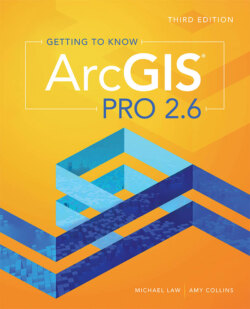Читать книгу Getting to Know ArcGIS Pro 2.6 - Michael Law - Страница 13
Basic GIS principles and concepts
ОглавлениеYou can visualize data in a GIS as layers in a map. You can represent geographic and manufactured objects on the earth in a map by symbols: points, lines, and polygons. In the accompanying map, points represent trees and points of interest; lines represent roadways; and the polygons represent building footprints, green space, and water. Point, line, and polygon data is also called vector data. Features of the same type—such as trees, roadways, or buildings—are grouped together and displayed as layers on a map. To make a map, you add as many layers as you need to tell a story. If you are telling a story about a river that seasonally floods, you add a river layer and past flood hazard layers. You can also add a land-use layer to visualize what type of property, such as agricultural or residential, is affected by the flooded river. If you are building a city map, you start with a boundary layer, a street layer, and building footprints. By adding more layers, you can build a map that describes the city to your readers.
Figure 1.5. Map of Abu Dhabi showing building footprints, points of interest, roads, green space, and water features. Map courtesy of Municipality of Abu Dhabi City.
If you make a map of your house, a lake, or a city park, you might draw an outline to represent the outer boundary. But what about natural phenomena—such as temperature, elevation, precipitation, ocean currents, and wind speed—that have no real boundaries? Weather maps show blue areas for cold and red areas for hot. Wind speed can be represented using a range of colors. Or you can instead record and collect measured values for any location on the earth’s surface to form a digital surface, also known as a raster. Captured location data is recorded in a matrix of identically sized square cells at a specific resolution—for example, 15 square meters. In the accompanying example, an analysis of an aquifer uses different rasters to calculate a result showing saturated thickness and usable lifetime.
Figure 1.6. Map of the Ogallala Aquifer showing a surface that represents the saturated thickness, water-level change, and projected usable lifetime of the aquifer. Map courtesy of Center for Geospatial Technology.
Features have locational data behind them. Features also contain attribute data, known as attributes. For a forestry map, point features that represent trees might include attributes such as tree species, height, bark thickness, and trunk diameter. For a utility map, lines that represent sewer pipes might include attributes such as flow rate, flow direction, pipe material, and length. Feature attribute information is stored in a table in a GIS database. Each feature occupies a row in the table, and an attribute field occupies a column. A GIS database can hold large collections of features and their corresponding attribute data. A GIS provides many tools for you to query, manipulate, and summarize large quantities of data.
Figure 1.7. A map with parcels, water lines, and valves. Attributes of the valve features include maintenance dates and information about valve type, size, usage, cover, lid type, and condition.
Data can be queried and analyzed. In a GIS, you can perform a query on all the data that relates to phrases, terms, or features that you choose. For example, you might be looking for clusters of low-income neighborhoods to analyze poverty levels per square mile. Querying data from a database allows you to display only the data that relates to a certain theme. Additionally, a GIS enables you to identify spatial patterns in the data through the use of geospatial processing tools. What is the problem you are trying to solve, and where is it located? The accompanying map shows analysis and a complex pattern of senior citizen out-migration. Depending on your project, you can choose from among hundreds of analysis tools.
Figure 1.8. Map of Portland, Oregon, showing net migration or deaths per acre because of “senior shedding” or out-migration. The red isolines identify concentrated areas in which mothers age 30 and over gave birth. Map courtesy of Portland State University.
